Using Case Studies in your marketing is a time-tested, proven method for generating more business. Savvy marketers in almost any industry agree that Case Studies are essential.
The reason? A Case Study that’s done well tells a success story from your client’s perspective. As prospects read the Case Study, they can easily imagine how much better their life would be if they just started working with you!
However, it isn’t enough to just have a collection of solid Case Studies. Posting them on your website, sharing them with clients, and sending them out in an email blast are all great marketing strategies. But if that’s all you’re doing with your Case Studies, you’re missing some big opportunities, because a well-produced Case Study has dozens of reusable elements that are absolute gold for marketing campaigns.
Read on to see our list of the most effective strategies for using your Case Studies within marketing campaigns and even building new campaigns around your Case Studies.
Use Case Studies as Remarketing Content
Using Case Studies as remarketing content is a very powerful B2B lead generation strategy. Try the following two-step approach with Facebook, Google, LinkedIn, or any other ad platform to generate B2B leads using Case Studies.
Step One: Run ads promoting strong top-of-funnel content
The strategy here is to run the content to your target audience members. It doesn’t matter if they’re familiar with your company or if they’re already in the market for your solution. The content will serve as the introduction.
However, the way you write this content should show how your product/service helps your target audience solve common industry problems. Doing so will get your audience to your content, which will help to prove the power of your product.
To get people to click to the content, the ad should bring this problem to the front of prospects’ minds and tease the solution the content explores.
As an example, we at SuccessKit would create an ad like the one shown in Figure 1 for an article titled “How to Boost Your Sales with Case Studies.”

Within the content, you can include some conversion call to actions (CTAs), such as “learn more,” but don’t count on a deluge of leads from this step. The point here is to get prospects reading your content.
Step Two: Remarket a relevant Case Study to everyone who visited your content in Step One
When it comes to using case studies in your marketing, this is your moneymaker, and it’s very simple. Your content displayed problems and showed clear steps to how your product or service is a solution. The Case Study remarket will remind your audience of this while focusing on a specific example of your company solving that exact problem.
The ad should recall the problem you presented in the content while connecting your brand’s solution.
Figure 2 shows a sample of our follow-up ad pushing our Case Studies.
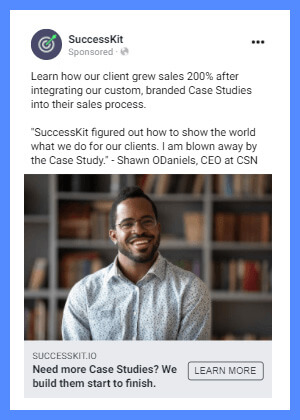
Test different images with the ad. Try your logo, a stock photo of people, or something completely different; you never know what might work. Experiment with integrating a quality client quote that supports your ad statement. If clients will allow you to use their images in your ads, this will add even more authenticity and credibility.
Having an effective landing page that can convert is essential to this strategy working. You’ll learn more about creating effective landing pages in the section titled “Add Case Study Elements on Landing Pages.”
Make Case Studies a Prominent Feature on Your Website
Having Case Studies front and center on your website sounds simple, but the method to do so is not always obvious. We even got it wrong initially on our new website, and we think about Case Studies all day, every day!
Originally, our website featured a link to “Our Own Case Studies.” It was a submenu item under “Resources” on the header. The page housed all of our own Case Studies, telling the tales of our happy clients.
Our reasoning: We figured that our interested prospects would take the time to look at all our resources and really vet what our clients were saying about us.
We were right, but only to an extent. Ultimately, we realized that we’d seriously undervalued the power of Case Studies being front and center on our main menu.
As you can see in Figure 3, we moved the link to our main menu and changed the menu item name to “Clients” to make it more interesting. (Note: You may want to call similar pages “Case Studies.” For us, we chose “Clients” since every page on our site is about Case Studies.)

Guess what? We saw a 110% increase in traffic to our Case Study page since making the switch!
Your prospects want to explore what life is like as your customer, and Case Studies are the best way to accomplish this. In short, put your Case Studies on your main menu and ensure they’re as easy as possible to find. You’ll see traffic to your page increase, and over time, you’ll see your sales increase too.
Use Case Study Components in Ads
Parts of your Case Studies, such as quotes and stats, make for perfect ad content and are easy ways to use Case Studies in marketing. Identify components like key data points from your Case Study to use as the primary text or body copy of an ad. Then, link to the full Case Study so prospects can review the details.
Figure 4 shows an example of a general ad for SuccessKit that uses a really strong quote to carry the message. This would be a great remarketing ad like that addressed in the first strategy. We can also run it as a general ad campaign.
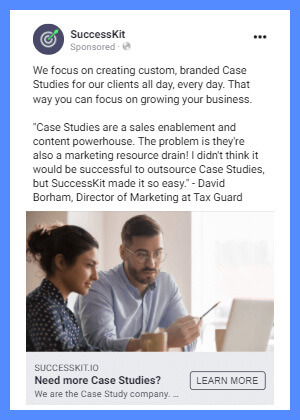
Also, try bringing in specific metrics from your Case Studies to your ads. Consider replacing the quote with a specific metric that’s relevant to most of your audience.
Add Case Study Elements on Landing Pages
Integrating relevant quotes and metrics into your landing pages really goes hand-in-hand with the third strategy. It’ll also help show your prospects the value you provide right when they’re about to convert.
Experiment with creating really simple landing pages for prospects further down the funnel. Be sure to include a lead form, some nice quotes, and a few sentences describing the value of your offering and what they’ll get with an appointment. If prospects are already familiar with your brand, this landing page style can work wonders.
Marketers often get carried away with wanting to sell their whole offering on a landing page, but this approach is confusing and distracting to potential clients. Sometimes, you just need to go for the close and book that appointment.
Figure 5 shows an example of how we integrated some quotes into a really simple landing page.
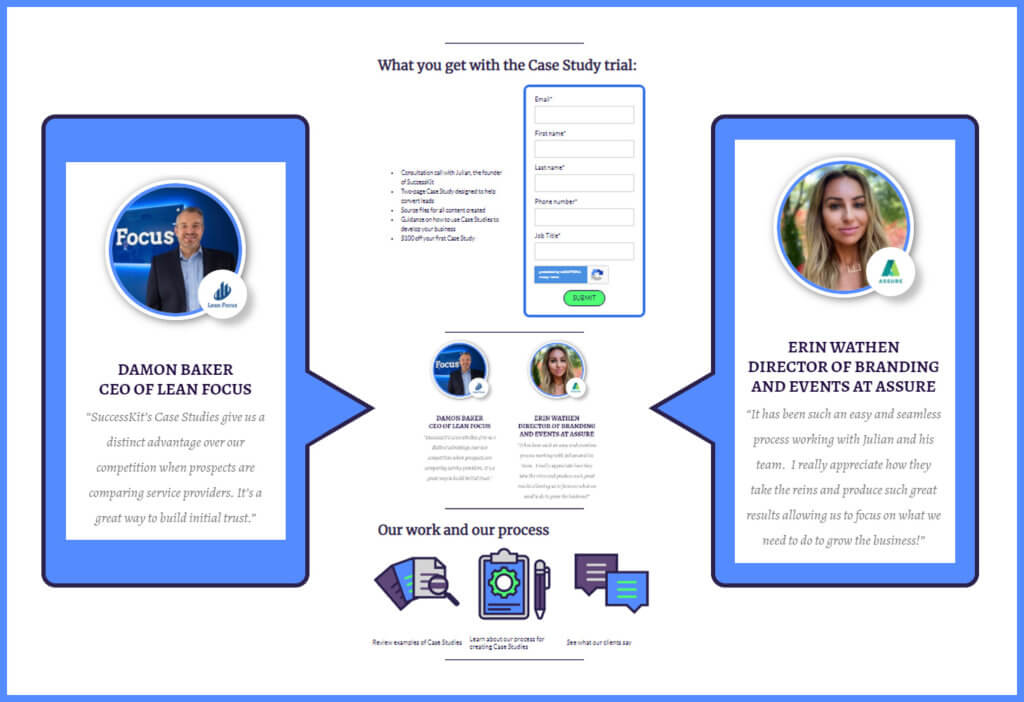
The landing page should integrate elements of your Case Study, such as key stats and quotes. Fire and foremost, include a form with a clear CTA so that you can convert the prospect.
Provide a Link to the Full Case Study in Your Newsletter
Add a Case Study to your newsletter. You can call it a “Customer Spotlight” to add a layer of community engagement while also touting your success. A regular section like this will give your readers continuity. They’ll also learn, over time, where to go when they want to learn about your customers.
Build this section above your footer, toward the bottom of the email. This is where you will feature your Case Study.
There are a dozen ways you could present this visually. One is to have a thumbnail with an image of the Case Study, like what we use on our own website (Figure 6).
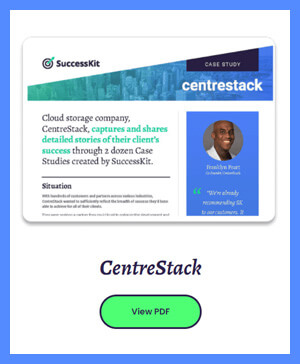
If you want to go the quick, easy, design-free method, just do a hyperlink text. Write a line or two of copy about the Case Study, such as “Click here to read about how we helped our client ABC Company boost their revenue by 110%.”
If you have multiple Case Studies, cycle the link on a regular basis to avoid putting out stale content.
Make Case Studies Part of Your Nurture Campaigns
Case Studies are an essential and compelling piece of any strong nurture campaign, which you should be running at every stage. (Review this great article on lead nurture if you want to understand this strategy better.)
You don’t want to hit a new lead with a Case Study right away. Instead, your nurture campaign will gradually introduce your prospect to the value of your brand, your content, and your offering.
As you gain more brand recognition and develop interest, that’s when you provide the Case Study.
Test different methods when you use Case Studies in your marketing nurture campaigns. Try slicing one up and putting the highlights in one of your emails. Consider teasing the Case Study and linking it to the full version.
Mix and match different methods, A/B test, and figure out what is going to work best in your campaign.
Conclusion
Telling effective stories is a cornerstone of effective marketing.
Having a stockpile of Case Studies is going to help you to market better, there is no doubt about it. And once you have those Case Studies, you need to give people a reason to care about reading them.
Have any thoughts for additional ways to use your Case Studies to boost your marketing? Drop a comment below.
Need Case Studies of your own? Click here to learn more about how SuccessKit can help.
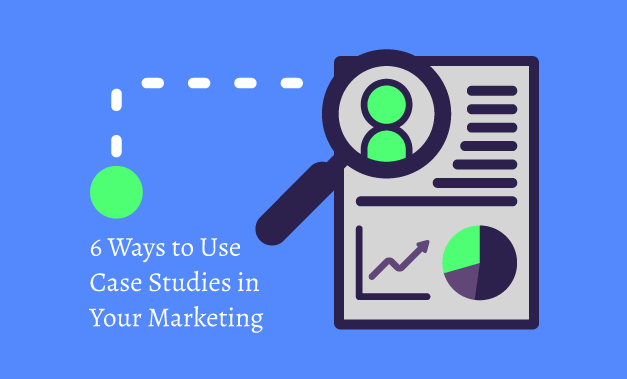



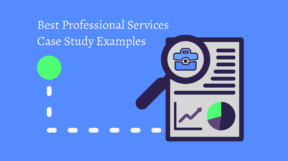
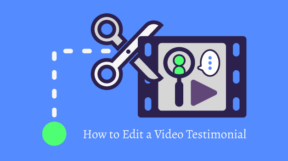
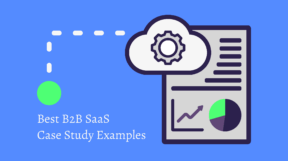
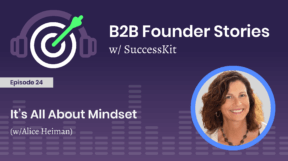

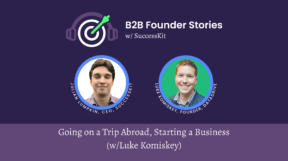

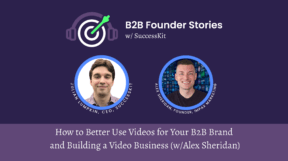
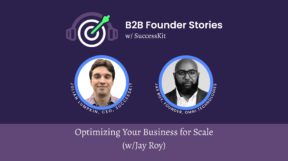














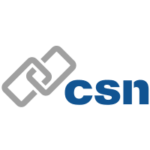

































Great tips, sharing now!